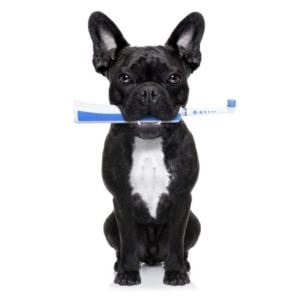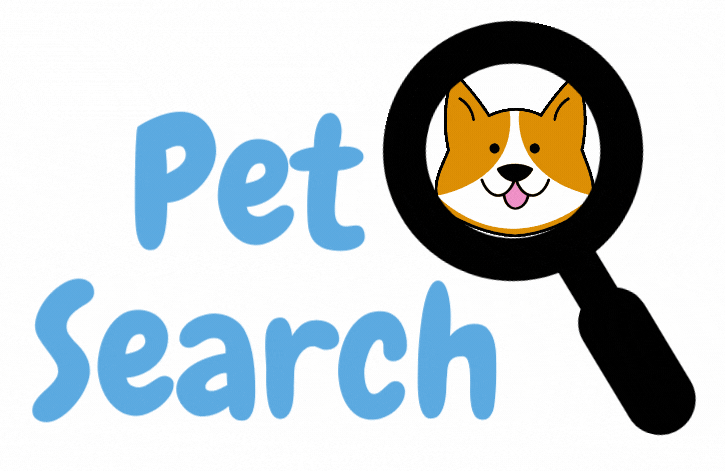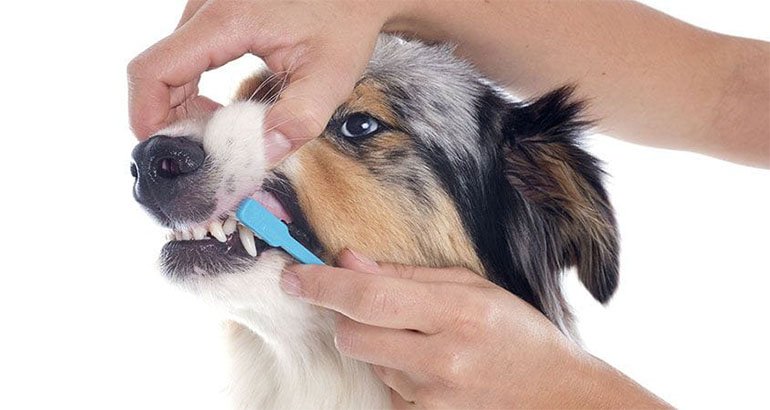Pet Search is a mother-daughter run blog. Together we have over 40+ years of professional pet grooming experience and we hope to pass some of that on to our readers throughout our in-depth and non-bias reviews and buyers guides.
We do not accept sponsored posts however we do include affiliate links throughout our posts and we receive a share of the revenue generated from your purchase which contributes to the running of CleanerPaws.com.
This review guide was updated in February 2019.

Do You Need to Clean Your Dog’s Teeth?
Do I need to brush my dog’s teeth is a question we get asked a lot at Pet Search, and we believe it is the one area of pet grooming that owners are most confused about.
There is just so much conflicting information out there it’s hard for even a professional to give an answer that works for all dog owners because the response is affected by many factors, including the breed of your dog and their diet.
A more natural question to ask is – How much do you love your dog’s doggy breath?
If your pet has breath that leaves your stomach turning and you dashing for the nearest toilet heaving in the process, then you may not be doing a great job looking after your dog’s dental hygiene.
Dogs, like humans, need their mouths cleaned regularly to keep them healthy.
Because of this, it’s imperative for you to learn how to brush your dog’s teeth correctly to keep them as healthy as possible.
You need to ensure proper oral care so your pet can grow old with all their teeth firmly intact.
Brushing your dog’s teeth regularly also means they have pleasant doggy breath every time they decide to slather you with wet, sloppy kisses.
So, let’s go into the details of how to give your dog’s teeth a real good clean.
First off, here’s a list of tools you’ll need to help you brush your dog’s mouth effectively:
You’ll need a toothbrush specially designed for dogs.
These toothbrushes feature medium strength, double bristles with brushes angled at a strict 45-degree angle.
These features help clean your dog’s teeth and gums effortlessly.
The tensile strength of the brushes is also the most comfortable for your dog’s mouth.
Next, you’ll need to choose the best toothpaste for your dog to help clean his canines.
Don’t use toothpaste made for humans as these are not properly formulated for your pet’s teeth.
This means they can cause more dental issues further down the line.
Last but not the least: you’ll need some chew toys as a reward that your dog can enjoy after.
Having these three essentials in your grooming kit is pretty much all it takes to care your dog’s dental health.
But, the challenges don’t stop there.
Brushing your dog’s teeth can be challenging since this is not a natural exercise dog’s would enjoy in the wild.
You’ll have to expect some struggle, and it isn’t uncommon for dogs to resist this strange sensation at first.
How to Brush Your Dog’s Teeth
The best answer would be to start this ritual while your dog is still a puppy.
It’s easier to train dogs when they’re at this stage in their development to accept some of the grooming rituals we put them through.
Cleaning your dog’s teeth is also a great way to keep an eye on their drinking habits, especially if you notice them beginning to drink more water than usual for example.
3 Steps to Cleaning Your Dog’s Teeth
Step 1 – The vast majority of dogs respond to the world through scents and sounds.
Let’s start with your puppy.
First, prepare the toothbrush and toothpaste and place it near to your dog.
You can introduce the cleaning implements by holding them under your puppy’s nose and then immediately providing a treat when they begin to sniff the scent.
Do the same thing for the toothpaste, hold it close to your dog’s nose and then provide a treat afterward.
By doing this, you are associating the scent of the toothbrush and the toothpaste in his mind as pleasurable things, and this positive reinforcement can go along way later on!
Step 2 – After a few seconds, lift the side of your dog’s lips and give the teeth a precursory brush.
Once done, provide another treat.
Do this several times until your pet is fully relaxed and willing to accept the strange repetition.
Again, this step is carried out to give your dog a connection between the brushing motion and receiving a treat.
Step 3 – Now, add a liberal layer of toothpaste to the toothbrush’ bristles and hold it close to your puppy’s nose again, providing another treat.
Slowly lift your dog’s lips up again and start brushing the teeth while voicing out praises for keeping calm.
Try to keep this session short for now.
Clean the visible sides of your dog’s teeth as quickly as possible and then rinse the mouth off with water.
After all of this is done, provide another treat and give out more praise as an additional reward.
If you do this regularly enough, your puppy will look forward to teeth cleaning time because they know treats will soon be arriving as well.
In your future sessions, you can lessen the amount of introduction and rewards and go right on ahead to cleaning your pet’s teeth.
Given enough time, you’ll be able to clean your dog’s mouth more thoroughly as they become accustomed to this strange ritual.
Just make sure you give out a treat afterward and praise him for being so well behaved.
You can also replace the treats at the end with his favorite chew toy to make sure his teeth remain clean after brushing.
This type of training can also be applied to older dogs, but you’ll have to put in more patience and double your efforts to keep them from wiggling or becoming unsettled.
The proper motion to brush your dog’s teeth
There is also a prescribed way to brush your dog’s teeth properly.
Just like with humans, brush your dog’s teeth with an up and down motion from the upper gum line to the lower gum line.
This removes any food particles embedded in the spaces between your pet’s teeth as well as those trapped in between the teeth and the gums.
Start with one side of the jaw and work your way towards the other.
If your dog is already accustomed to this grooming ritual, open your dog’s mouth and clean the inner sides of their teeth.
Do this as quickly as you possibly can to avoid stressing your pet out.
Make sure you brush the roof of your dog’s mouth as food particles, as well as bacteria, can flourish there if left unattended.
Lastly, give your dog’s tongue a quick brush or two to remove any leftover food.
Make sure you keep your dog as calm as possible all throughout this session and give hem plenty of vocal praises and rewards.
How often should you brush your dog’s teeth?
There are different views on the regular schedules involved in brushing your dog’s teeth.
How often should you do it? Once a week? Three times a week?
Should it be a daily ritual?
According to some veterinarians, it is best to clean your dog’s teeth once every three days, and that is what we try to stick with as well.
Other Helpful Dog Teeth Cleaning Tips
Make sure you have your dog’s mouth and teeth checked out by your vet whenever you take them for a visit so you can get some extra professional help regarding the oral care you give to your dog.
Also, consider sticking to dry dog food instead of wet food to minimize the amount of cleaning needed per week.


2 comments